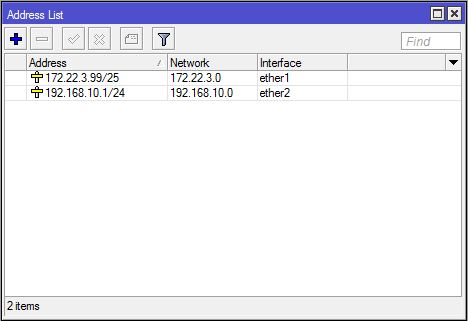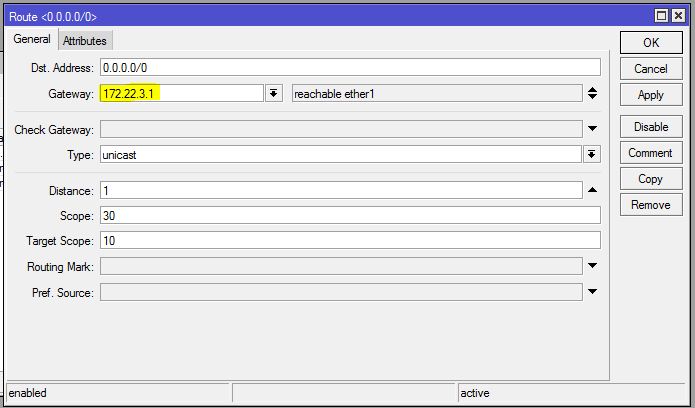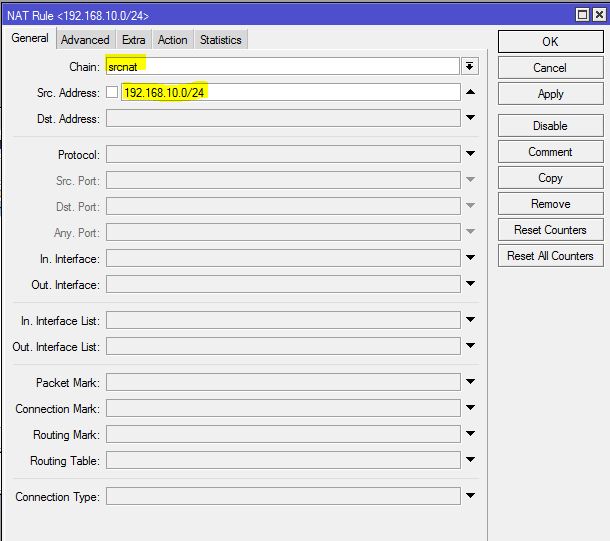MikroTik is one of the most popular routers. MikroTik Router has a lot of networking services that help to build a stable and smooth network so easily. It is said that any ISP Company or any Enterprise Office cannot go a single day without MikroTik Router. So, system administrators who are not using MikroTik Router yet, they will soon start using MikroTik Router, I think. As a system administrator, I am also using MikroTik Router about 5 years in my network and really I have got a very stable and smooth network. MikroTik Router is mainly famous for bandwidth control service and packet filtering functionalities as well as cheap price. MikroTik Router is also favorite to any system administrator because of having graphical user interface (GUI) software named Winbox which helps to manage MikroTik Router so easily. As the usage of MikroTik Router is growing rapidly, this article is designed to show the basic configuration of a MikroTik Router from very beginning using Winbox software so that a new MikroTik Router user can easily configure his/her router from very starting and can operate his network smoothly.
Prerequisites to Configure a MikroTik Router
Before going to start basic configuration of a MikroTik Router you should have below the information.
- Basic knowledge on IP Addressing.
- A MikroTik RouterBoard or MikroTik RouterOS installed on a PC.
- Winbox Software.
- PC with windows operating system installed and RJ45 cables.
If you have the above requirements properly, you are now ready to start MikroTik router basic configuration. The rest of this article will show the step by step guide to configure a MikroTik Router from very beginning.
4 Easy Steps to Configure a MikroTik Router
MikroTik Router basic configuration includes assigning IP addresses, configuring default gateway and enabling NAT for accessing internet. MikroTik Router basic configuration can be divided into 4 steps.
- Assigning WAN and LAN IP addresses
- Gateway configuration
- NAT configuration and
- DNS configuration
Among the above 4 steps, first three steps are mandatory for accessing internet trough your MikroTik router and step 4 is optional but it must be done for proper MikroTik Router configuration.
To configure a MikroTik Router properly according to the above 4 steps, I am using the following information and a simple office network diagram where three users are connected to MikroTik Router through a network switch and the first interface of the router is connected to internet for accessing internet information.
- MikroTik RouterBoard 1100 AHX2
- WAN IP: 172.22.3.99/25 (ISP provided)
- Gateway: 172.22.3.1 (ISP provided)
- Public DNS: 8.8.8.8 and 8.8.4.4
- LAN IP Network: 192.168.10.0/24 (Private IP block chosen by me)

According to our simple office network diagram, first interface (ether1 port) is connected to ISP internet and this interface is our WAN port. We will set our WAN IP (provided by ISP) in this interface. Second interface (ether2 port) is our LAN interface and we will set our LAN Gateway in this interface. The users of this network will be connected to MikroTik Router trough a switch for accessing internet. In practical, your network will not be so simple like this network diagram. You may have to maintain a large network where there may have hundred or thousand of users. But the basic configuration is same for all networks. However, we will now start our MikroTik Router basic configuration according to the above 4 steps and following our simple office network diagram.
Step 1: Assigning WAN and LAN IP Addresses
The first step to configure a MikroTik Router is to assign WAN and LAN IP addresses in WAN and LAN interface accordingly. The following steps will show how to assign WAN and LAN IP addresses in a new MikroTik Router.
- Download Winbox or collect Winbox from any source.
- Connect your PC with MikroTik Router by a RJ45 cable.
- Open winbox software in your operating system and click on Neighbors tab. Connected Ethernet’s MAC will appear in this tab. If you don’t find MAC Address, click on Refresh button. MAC address will appear soon. Click on the appeared MAC address and selected MAC address will be appeared in Connect To input box.
- MikroTik Router default username is admin and password is blank. So, type admin in the login input box and password field left blank and then click on Connect button. MikroTik graphical user interface (GUI) will appear now.
- Now click on Remove Configuration button if prompted or from Winbox go to System > Reset Configuration and click No Default Configuration and then click on Reset Configuration button to reset RouterOS. Router will be rebooted and login again and then you will find a zero configuration RouterOS.
- Go to IP > Addresses menu item. Address List window will appear now. Click on PLUS SIGN (+). New Address window will appear. Put your WAN IP address (In this article: 172.22.3.99/25) which is provided by your ISP in Address input box and then select WAN interface (in this article: ether1) from the Interface drop-down menu and click Apply and then OK button.
- Click PLUS SIGN (+) again and put LAN Gateway IP address (in this article: 192.168.10.1/24) in Address input box and choose LAN interface (in this article: ether2) from Interface drop-down menu and click Apply and OK button.

Assigning WAN and LAN IP addresses has been completed. We will assign MikroTik gateway which is provided by ISP so that MikroTik Router can communicate to internet through this gateway.
Step 2: Gateway Configuration
After completing WAN and LAN IP setup, we will now assign MikroTik default gateway which is provided by ISP. The following steps will show how to assign default gateway in MikroTik Router.
- From Winbox, go to IP > Routes menu item. Route List window will appear now. You can see two dynamic routes are already added in this Route List. Click on PLUS SIGN (+). New Route window will appear. Now put gateway address (in this article: 172.22.3.1) which is provided by your ISP in Gateway input field.
- Now click Apply and OK button.

MikroTik default gateway configuration has been completed. Now we will create NAT rule so that MikroTik Router can masquerade our LAN user IP to access internet.
Step 3: NAT Configuration
After completing gateway configuration, you have to create a NAT firewall rule to masquerade LAN IPs. Otherwise, LAN user cannot access internet through MikroTik Router. The following steps will show how to create masquerade firewall rule in MikroTik Router.
- Go to IP > Firewall menu item and click on NAT tab and then click on PLUS SIGN (+) button. New NAT Rule window will appear.
- From General tab, choose srcnat from Chain drop down menu and put LAN IP Block (in this article: 192.168.10.0/24) in Src. Address input box.
- From Action tab, choose masquerade from Action drop down menu and then click Apply and OK button.

NAT configuration in MikroTik Router has been completed. if you do not create this NAT rule, your LAN user cannot access internet through MikroTik Router.
Three mandatory steps for configuring a new MikroTik RouterOS to access internet has been completed. LAN users are now able to access internet through Mikrotik Router if they use custom DNS server IP. But we will now configure DNS in MikroTik Router so that it can resolve DNS request as well as it can work as a DNS server.
Step 4: MikroTik DNS Configuration
After completing three mandatory configuration, we need to configure DNS in MikroTik Router so that it can resolve DNS request from the LAN user as well as itself. The following steps will show how to configure DNS in MikroTik RouterOS.
- Go to IP > DNS menu item. DNS Settings window will appear. In this window, put DNS server address that you have got from ISP company or you can put Google public DNS IP (8.8.8.8) in Servers input box. You can put secondary DNS server IP by clicking add new value button (drop down button) located after the Servers input box. Optionally, you can turn MikroTik router as a DNS server. Turning MikroTik router as a DNS server is a better idea, I think. Because if you use public DNS server in your network, every DNS request of your user will consume your paid bandwidth. But if you turn MikroTik router as a DNS sever, your user will get DNS solution from MikroTik Router without consuming paid bandwidth. So, if you want to turn MikroTik into a DNS server, click the Allow Remote Requests check box and click Apply and OK button.
- If you turn MikroTik Router into a DNS server, all MikroTik IP addresses can be used as a DNS server IP including WAN IP which is a public IP and problem will arise here. If anyone outside of your LAN use WAN IP as a DNS IP, your MikroTik will be happy by serving him/her DNS solution consuming your paid bandwidth. So, you must stop DNS request from outside of your LAN. For stopping DNS request from outside of your LAN, you should apply firewall rules which will drop all DNS requests coming from your WAN interface (in this article: ether1). For this, go to IP > Firewall menu item and click on Filter Rules tab and then click on PLUS SIGN (+). New Firewall Rule window will appear. From General tab, choose input from Chain drop down menu, choose udp from Protocol drop down menu, Put Dst. Port 53 and choose ether1 from In. Interface drop down menu. Now click on Action tab and choose drop from Action drop menu and then click Apply and OK button. You must create another similar rule for TCP connection. For this, click on PLUS SIGN (+) again and choose tcp from Protocol drop down menu, Put Dst. Port 53 and choose ether1 from In. Interface drop down menu and then click on Action tab and choose drop from Action drop menu and click Apply and OK button. Now your MikroTik DNS server is safe from outside of your LAN.

DNS configuration in your MikroTik Router has been completed. Now your MikroTik Router is able to resolve DNS request for the LAN user as well as itself.
MikroTik Router is now completely ready if you follow the above 4 steps properly. Connect a switch to MikroTik LAN interface with RJ45 cable and connect all PCs to this switch. Also connect ISP cable to WAN interface. Now assign IP to all your LAN PC according to your LAN IP network series. If you face any problem to set IP address in windows PC, follow my another article about how to assign static IP address in windows operating system which will guide you the proper way to assign IP address in any windows PC. Now browse any website or ping google.com from your LAN PC. If your ISP is OK, you will now be able to browse any website successfully.
You should follow the above 4 steps so carefully to configure your new MikroTik Router successfully. If you miss any step, your configuration will be wrong and your LAN users will not be able to access internet through MikroTik Router. If you face any confusion to do the above 4 steps, watch the following video tutorial on MikroTik Router Basic Configuration using Winbox. I hope, it will help you enough to configure new MikroTik Router.
MikroTik Router basic configuration is not so enough to maintain a real network. If you need to maintain an office network, it will be better to use MikroTik DHCP Server. Managing DHCP Server with Radius Server will provide you more faster and smart solution.
Again, if you want to maintain an ISP network, MikroTik PPPoE Server is a better solution. MikroTik PPPoE Server with Radius Server will provide you a prepaid billing system also.
If you plan to maintain a Hotel, Airport, Railway, Restaurant network or any ISP network with WiFi solution, MikroTik Hotspot Server is your best friend. Using Radius Server with Hotspot, you can manage Bandwidth with Prepaid Billing System as well as Data Limit with Prepaid Billing System.
In addition, if you find bandwidth management solution with MikroTik Router, MikroTik Bandwidth Management with Simple Queue will be enough helpful. But it will be better to Manage ISP Bandwidth with MikroTik PCQ.
Sometimes, you may need load balancing and link redundancy solution. Then, go through MikroTik Load Balancing and Link Redundancy with ECMP.
MikroTik Router Basic Configuration has been explained step by step in this article. I hope, you will now be able to configure a new MikroTik Router successfully from very beginning. However, if you face any confusion to configure your MikroTik Router, feel free to discuss in comment or contact with me from Contact page. I will try my best to stay with you.